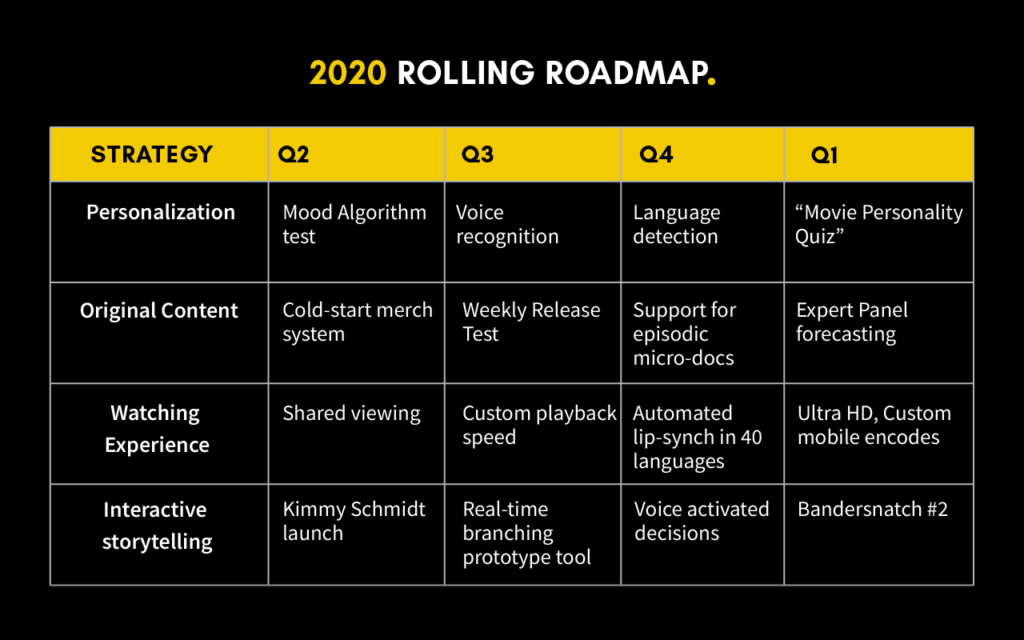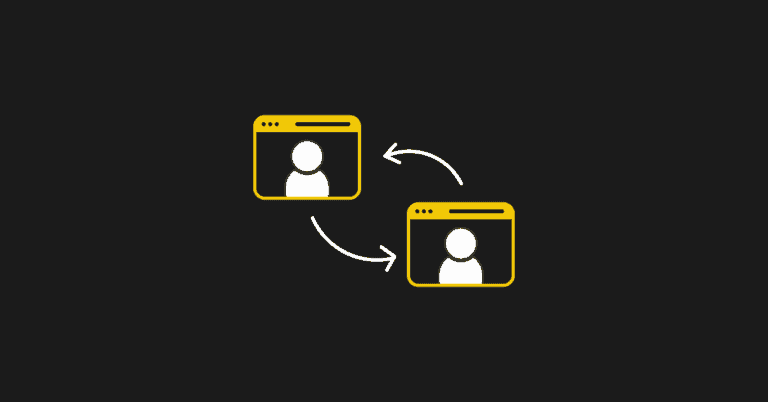Netflix was the world’s largest streaming service in 2020 with over 193 million subscribers and climbing. Software as a service (SaaS) companies took notice and wanted in on the secret sauce to Netflix’s product strategy.
What was their secret to onboarding new users and customer success?
I’m going to share a few models to help you define your product strategy. Each of these models will be brought to life with a mock 2020 articulation of Netflix's product strategy.
But first, how Netflix started...
Netflix’s product vision began with a simple goal – to get big on DVD. When Netflix started out, they were a DVD rental company, and customers had DVDs delivered to them via postal services. Then, the company’s vision evolved to become a leader in the streaming market. Going digital enabled Netflix to expand worldwide. Having achieved all of the above, Netflix is currently placing a strong focus on original content.
What is a product strategy?
Product strategy is a key part of product-led growth (PLG). It’s a plan that helps your company establish a specific product vision and how teams work together to successfully achieve it.
Before we begin to explore Netflix’s product strategy, it’s important to understand why product strategy is so important and necessary.
Firstly, a strategic product plan helps us to communicate an inspired vision of the future. It’s one thing to have an idea in your head, but you need the right strategies in place to help communicate that vision to others.
Secondly, combining innovation and invention is no easy task. Inventing new solutions and features can be chaotic, and it’s almost impossible to be innovative without any chaos. However, products change, and company decisions cannot happen at random. There must be discipline, and a product development strategy is effective at blending these two forces.
A product development strategy is about forming hypotheses to what I call the DHM model. In other words, you need it to delight customers and do so in a margin-enhancing way.
Finally, you need a product strategy to help facilitate prioritization. We must prioritize some things over others, and having a strategy in place can help you to do that while also communicating a plan.
As product leaders, we can do anything, but we can’t do everything.
3 product strategy frameworks
A product strategy framework is a guiding light for every department in your SaaS company. I want to briefly introduce three models for product strategy because I’ll be sharing (in later sections) how to put each to use in the context of Netflix’s 2020 product strategy.
Here are three models (or frameworks) to define your product strategy:
- Get Big, Lead, Expand (GLEe) model is a product strategy model that helps provide a long-term vision. It’s about growing the company to get big in its first 5 to 10 years and then expanding into different chapters of growth later.
- Grow, Expand, Monetize (GEM) model helps different departments like marketing, finance, and Product teams to align with each other. How do you prioritize growth, expansion, and monetization?
- Delight, Hard to Copy, Monetize (DHM) model is about delighting your users in hard-to-copy ways.

The purpose of these models includes:
- Encourage people to think long-term
- Build cross-functional alignment
- Help people to form hypotheses to compete long-term
Netflix’s DHM product strategy framework
If you’re a product leader, like Netflix in 2020, your main job is to delight customers in hard-to-copy margin-enhancing ways.
So, how did Netflix’s product leaders achieve this?
Netflix uses a DHM framework.
The company offers customers a very convenient service with a wide selection of movies and TV shows they can stream instantly anytime, anywhere. Customers can navigate Netflix’s selection very easily, and they get a lot of value for their money. Plus, Netflix offers customers a range of high-quality and entertaining original content.
How Netflix’s product strategy increases profits
A key part of Netflix’s product strategy is to increase profits so they can reinvest in making an even better product in the future. I refer to this as margin-enhancing and Netflix effectively increases profits in various ways.

Let’s take a closer look at the last point in the graphic above – right-size original content investment.
Since Netflix wants to offer a wide range of movies and TV shows to suit all types of tastes and preferences, the company likes to invest in original content. However, they want to pay the right amount for this content.
To do this as accurately as possible, Netflix predicts how many people will watch a certain TV show or movie and then line up the cost of investment with their prediction.
For example, Netflix predicted that 100 million people would watch their original series Stranger Things. Therefore, they were willing to invest $500 million in that series. The series Bojack Horseman was predicted to gain 20 million viewers, so the right-size investment in that show was estimated to be $100 million.
What made Netflix’s 2020 product strategy hard to copy
In 2020, Netflix wasn’t the world’s biggest streaming service for nothing. It was very hard for other companies and streaming services to copy what Netflix did, and that made it difficult for competitors to compete.
Netflix is a trusted brand. You can trust Netflix to keep your details private. Their brand promise is “movie enjoyment made easy,” and they achieve this by providing viewers with personalized service and the freedom to watch on almost any device with an internet connection.
Here’s why Netflix is hard to copy:
- Brand
- Unique technology
- Network effect
- Economies of scale

The brand promise of Netflix is movie enjoyment made easy. The company is a movie subscription service that delivers fast, easy entertainment in a friendly, straightforward way.
Priorities of Netflix's product team
The product team at Netflix prioritizes monthly retention as the company’s high-level engagement metric. The team prioritizes other metrics too, including growth and monetization.

When the COVID pandemic hit in 2020, movie theaters were closed, and more people had free time at home. The company’s product team focused on key high-level product strategies (see below):

Here’s an example of the Netflix 2020 rolling roadmap, which shows how Netflix is implementing each strategy every quarter:

Netflix case studies
Now, let's look at some ways Netflix was able to win their users' attention by offering additional products.
Case Study 1: Netflix Party
Netflix Party (now Teleparty) is a Chrome extension app that has become increasingly popular since COVID-19. It allows users to watch the same movie at the same time. They can even chat with each other while watching a movie or TV show.

In an isolated time, such as a lockdown during the pandemic, many people enjoyed using this Chrome extension to watch movies with friends and family long-distance.
But is this an idea that Netflix should execute itself?
In the past, Netflix has tried a few variations of social experiments, including Friends in 2009, Xbox Party Mode in 2010, and Tell a Friend in 2018. All three were killed off because not enough people used the features.
However, Netflix Party has proven to be quite a success. In 2020, the app grew from 500 thousand to one million in just 60 days and acquired 10 million downloads. This data shows a substantial proof of concept, making it a possible worthwhile investment for Netflix. But the question remains – will this delight in hard-to-copy, margin-enhancing ways?
Well, this extension is hard to copy, and it would take competitors years to mimic something of this scale. It has the potential to enhance profits via word-of-mouth and increase retention.
Case Study 2: Auto-cancel inactive members
Should Netflix auto-cancel inactive members?
In 2020, one-half percent of Netflix members hadn’t used the service in the last 12 months. However, those members were still paying for the service despite rarely using it.
Some might argue that a better alternative would be to send those members an email notification alerting them to the fact they’ve been inactive for so long. The email could say something like, “Would you like to cancel?” Then, the user could decide whether they wanted to continue paying for the monthly subscription or cancel their membership.
If members say no, then their service will continue as normal. If they say yes, then their membership will be canceled. However, what happens to the members who don’t respond? Should their membership be auto-canceled?
In 2020, if Netflix were to auto-cancel all of the inactive members, the company would lose $100 million. Clearly, introducing the auto-cancel option was not a great way to enhance profits, as the company would be losing millions of dollars each year. But what about the delight and hard-to-copy side of their product strategy?
Offering the auto-cancel feature for inactive users may delight customers since Netflix automatically stops payments. The user could always rejoin if they choose to do so.
Auto canceling inactive Netflix users, in my opinion, would be a worthwhile strategy for Netflix to implement and here’s why:

I think that product teams and product leaders can learn a lot from Netflix’s winning 2020 product strategy, which can help you make more strategic day-to-day decisions and implement product strategies that will help you reach your vision and goals.
If you're finding it tough to nail your product-led strategy and need clearer direction for your SaaS company, you might benefit from expert guidance.
ProductLed Academy helps you and your team focus on the essentials: understanding your market, defining a winning strategy, building key capabilities, and making smart strategic choices.
The coaching program uses a nine-component framework, with building a winning strategy being the first step. This proven approach helps you scale efficiently and profitably.
Ultimately, the program's goal is to put you and your product-led team on the path to become The Obvious Choice — the best and easiest solution in your SaaS industry. Learn more and apply today.









